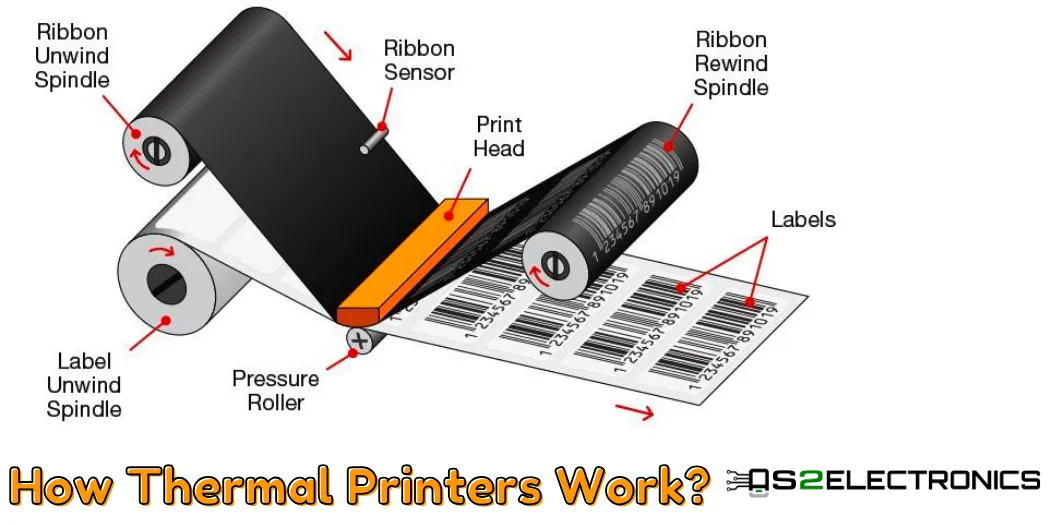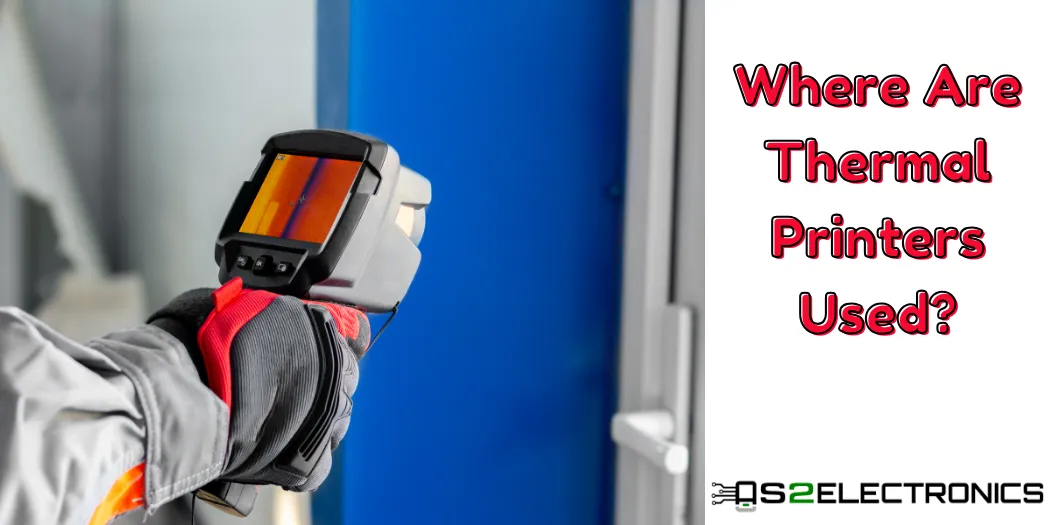In this article, we introduce the thermal printer, how it works, its advantages and disadvantages, and its various applications. In today’s world, printing plays an important role in exchanging information and recording events. Among different types of printers, thermal printers have found a special place due to their simplicity, speed and affordability. A thermal printer prints images and text by applying heat on heat-sensitive paper or labels. This type of printer does not need ink or toner and is very affordable. In the rest of this article, we will examine these printers in more detail and provide you with comprehensive information.
What is a thermal printer?
At the beginning of the introduction of thermal printer, it is better to know what is meant by thermal printer? As we said, a thermal printer is a type of printer that uses heat to print images on paper or other materials. These types of printers do not require ink or toner and instead use heat-sensitive paper or labels. As the printer head heats up, the desired dots on the paper or label darken, creating the final image.
Thermal printers, which are currently used in many industries and everyday uses, have traveled a long journey from the time of invention to today. The origins of thermal printers can be traced back to the late 1950s, when the first devices based on this technology were introduced for industrial applications. These devices were mainly used to print charts and graphs in large dimensions.
In 1965, the American company Datapoint released the first commercial thermal printers for printing store receipts. This invention was a turning point in the history of thermal printers and expanded their use beyond industrial environments. During the 1970s, we saw significant advances in thermal printing technology. The size and price of printers gradually became smaller and cheaper, and their use was expanded to various industries such as warehousing and transportation.
In the 1980s, thermal printers increasingly entered the home consumer market. Their common uses included printing sales invoices, mailing labels, and low-quality images. With the advent of personal computers and the Internet, the demand for thermal printers increased significantly. These types of printers have become one of the most popular choices for home and office use due to their speed, affordability, and ease of use.
Buy Best portable printer and scanner
How thermal printers work?
In the continuation of the introduction of the thermal printer, we will discuss and examine how thermal printers work. It is better to know that thermal printers are classified into two general types. In a direct thermal printer, the printer head directly contacts the thermal paper and when the desired points are heated, the image or text is printed. This method of printing is fast, simple and economical, but the durability of printing is low and it fades when exposed to light and heat.
In this type of printer, heat sensitive paper is used. In a thermal transfer printer, a ribbon dipped in ink or wax is placed between the printer head and thermal paper. By heating the desired points, the printer head melts the ribbon and transfers the ink or wax to the paper, thus printing the image or text. This printing method has a longer shelf life and also provides the possibility of color printing.

How thermal printers work is as follows: thermal paper, which is sensitive to heat, is covered with a layer of chemicals that change color and turn black due to heat. The printer head consists of many small elements, each of which can be heated separately. The computer or source device sends a signal to the printer that contains information about what to print. This signal is transmitted to the printer head. Based on the received signal, the printer head heats its small elements at specific points. In the areas where the small elements are heated, the heat is transferred to the heat-sensitive layer of the paper and changes the color of those points and creates the desired image or text.
Also Read: thermal printer vs inkjet printer
Advantages and disadvantages of thermal printers
After introducing the thermal printer, now that you are familiar with these printers, it is better to get acquainted with the positive and negative points of the thermal printer. Using thermal printers has its own advantages and disadvantages. By considering these advantages and disadvantages as well as your needs, you can choose the right type of printer.
If you are looking for fast, easy and cheap printing and print quality and durability are not important to you, thermal printer can be the right option for you. But if you are looking for high quality printing, color printing and long lasting, you should use another printer such as inkjet printer, laser or dot matrix printer.
A) Advantages of thermal printers
- No need for ink and cartridges: This saves significant costs over time, especially for applications that require a lot of printing.
- Ease of use: Thermal printers generally have fewer buttons and use simpler software, making them easier and faster to set up and use.
- Silent: Compared to inkjet or laser printers, these types of printers are much quieter and are ideal for use in environments where silence is important, such as libraries or hospitals.
- Affordable: Thermal printers are generally less expensive than other types of printers and are available in a variety of models and sizes to meet different needs and budgets.
- Efficient and fast: In monochrome printing, thermal printers can be faster and more efficient than other types of printers and are ideal for printing receipts, tickets and labels.
- Durable: Thermal printers generally last longer than other types of printers and require less maintenance.
- Connectivity: Many thermal printers can be connected to various devices such as computers, tablets or smartphones, which provides users with high flexibility.

B) Disadvantages of thermal printers
- Limited print quality: Thermal printers are generally not suitable for printing photos or high-detail images, and their print quality is lower compared to inkjet or laser printers.
- No color printing: Most thermal printers can only print in monochrome (usually black and white). For color printing, a thermal transfer printer and color ribbon are needed.
- Sensitivity to heat: Thermal printers are sensitive to heat and must be kept in cool conditions. Excessive heat can damage the print head and affect print quality.
- Non-permanence of printing: Thermal printing fades over time and with exposure to light and heat. This is not suitable for prints that require a long shelf life, such as medical records or financial documents.
- Restrictions on printing on materials: Thermal printers can only print on heat-sensitive paper or labels. To print on other materials such as fabric, metal or plastic, other printing methods such as sublimation printing or laser printing should be used.
Also Read: portable printer Shopping Guide in Dubai
Table of advantages and disadvantages of thermal printers
| advantages | disadvantages |
|---|---|
| No ink and cartridge, cost-saving | Poor color printing |
| Easier and faster to use | Higher ink consumption if overheated |
| Best option for quiet environments and offices | Printhead damage due to excessive heat |
| Economical | Lack of print durability |
| Variety of models | Limited to printing on certain materials |
| More efficient and faster in monochrome printing | |
| More durable than other printers | |
| Ability to connect to various devices |
Where are thermal printers used?
At the end of the introduction of thermal printers, we discuss the application and uses of these printers. Thermal printers, once only used in industrial applications, are increasingly used in a wide range of industries and businesses due to advantages such as high speed, simplicity and affordability. Currently, thermal printers have found much wider use and are used in a wide range of industries and everyday uses.
In this section of thermal printer introduction, we mention some of the most common applications of this type of printer:
1. Retail:
- Print purchase receipts
- Price label printing
- Printing discount labels
- Printing receipts for returning goods
2. Online retail:
- Print shipping and return labels
- Print the address label
- Barcode label printing
- Invoice printing
3. Home businesses:
- Brand label printing and promotional materials
- Print receipt and product specifications
- Print business cards
- Label printing for product packaging

4. Warehousing:
- Shelf label printing
- Print inventory labels
- Printing receipts of goods arrival and departure
5. Shipping:
- Print bill of lading
- Printing shipping labels
- Printing receipts for goods delivery
6. Medicine:
- Printing copies
- Print medical reports
- Printing laboratory labels
- Queuing printing
7. Government departments:
- Printing of certificates
- Print licenses
- Printing of other government documents
8. Banking:
- Print ATM receipts
- Printing of queue numbers
- Print bank statements
9. Food services:
- Print order receipts
- Print food menus
- Food label printing
10. Public transportation:
- Ticket printing
- Printing credit cards
11. Manufacturing industries:
- Printing product labels
- Print instructions for using the product
- Print quality control reports
12. Art and design:
- Print portfolio for introduction
- Sticker printing
- Gilding printing
13. Cosmetics:
- Tattoo sticker printing
- Nail lens label printing
14. Household uses:
- Label printing for personal items
- Label printing for food storage containers
- Print greeting cards
- Printing gift tags
Buy Best Portable Projectors in dubai
What kind of paper do thermal printers use?
Thermal printers use a special type of paper called thermal paper. This type of paper is coated with a layer of heat-sensitive chemicals that change color when heated and create the desired image or text. This type of paper is specially designed for thermal printing, and due to heat, the color of chemicals on it changes.





